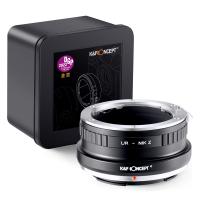What Is A Quantum Microscope ?
A quantum microscope is a type of microscope that uses quantum entanglement to enhance its imaging capabilities. It works by using entangled photons to illuminate the sample being imaged, which allows for higher resolution and sensitivity than traditional microscopes. This is because entangled photons can be used to detect very small changes in the sample, such as changes in the magnetic field or the presence of certain molecules. Quantum microscopes have the potential to revolutionize many fields, including medicine, materials science, and biology, by allowing researchers to see things that were previously invisible. However, they are still in the early stages of development and are not yet widely available.
1、 Definition and principles of quantum microscopy

What is a quantum microscope?
A quantum microscope is a type of microscope that uses quantum mechanics principles to achieve high-resolution imaging. It is based on the concept of quantum entanglement, which allows for the precise measurement of the properties of individual particles.
In a quantum microscope, a beam of entangled particles is used to probe the sample being imaged. The entangled particles interact with the sample, and their properties are measured to create an image of the sample. Because the particles are entangled, their properties are correlated, allowing for highly precise measurements.
One of the key advantages of a quantum microscope is its ability to image samples with high resolution. This is because the entangled particles used in the microscope can be manipulated to achieve very precise measurements. Additionally, because the microscope uses quantum mechanics principles, it is not subject to the same limitations as traditional microscopes, such as the diffraction limit.
The development of quantum microscopy is still in its early stages, and there is much research being done to improve its capabilities. One area of focus is the development of new types of entangled particles that can be used in the microscope. Additionally, researchers are working to improve the sensitivity of the microscope, which would allow for even higher resolution imaging.
Overall, quantum microscopy has the potential to revolutionize the field of imaging, allowing for unprecedented levels of precision and resolution.
2、 Types of quantum microscopes (scanning, transmission, etc.)

What is a quantum microscope?
A quantum microscope is a type of microscope that uses quantum mechanics principles to observe and manipulate matter at the atomic and subatomic level. It allows scientists to see and control individual atoms and molecules, which is not possible with traditional microscopes.
Types of quantum microscopes:
There are several types of quantum microscopes, including scanning tunneling microscopes (STM), atomic force microscopes (AFM), and transmission electron microscopes (TEM). STM and AFM use a tiny probe to scan the surface of a sample and create an image of its atomic structure. TEM, on the other hand, uses a beam of electrons to pass through a thin sample and create an image of its internal structure.
The latest point of view:
Recent advancements in quantum technology have led to the development of new types of quantum microscopes, such as the quantum diamond microscope (QDM) and the nitrogen-vacancy microscope (NV). These microscopes use diamond-based sensors to detect the magnetic fields of individual atoms and molecules, allowing for even more precise imaging and manipulation.
Overall, quantum microscopes have revolutionized our understanding of the microscopic world and have opened up new avenues for research in fields such as materials science, chemistry, and biology.
3、 Quantum entanglement and its role in quantum microscopy

What is a quantum microscope?
A quantum microscope is a type of microscope that uses quantum mechanics principles to achieve high-resolution imaging. It works by using entangled photons to illuminate the sample, which allows for the detection of very small changes in the sample's properties. This technique is particularly useful for imaging biological samples, as it can provide detailed information about the structure and function of cells and tissues.
Quantum entanglement and its role in quantum microscopy:
Quantum entanglement is a phenomenon where two particles become connected in such a way that the state of one particle is dependent on the state of the other, regardless of the distance between them. In quantum microscopy, entangled photons are used to illuminate the sample, which allows for the detection of very small changes in the sample's properties. This technique is particularly useful for imaging biological samples, as it can provide detailed information about the structure and function of cells and tissues.
Recent developments in quantum microscopy have focused on improving the resolution and sensitivity of the technique. One approach is to use quantum dots, which are tiny particles that emit light when excited by a laser. By using entangled photons to excite the quantum dots, researchers can achieve higher resolution imaging than with traditional microscopy techniques.
Another approach is to use superconducting detectors, which are extremely sensitive to changes in the electromagnetic field. By using entangled photons to probe the sample, researchers can detect very small changes in the sample's properties, which can provide information about its structure and function.
Overall, quantum microscopy is a promising technique for imaging biological samples with high resolution and sensitivity. As researchers continue to develop new approaches and technologies, it is likely that quantum microscopy will become an increasingly important tool in the field of biology and medicine.
4、 Applications in biology, materials science, and nanotechnology

What is a quantum microscope? A quantum microscope is a type of microscope that uses quantum mechanics principles to achieve high-resolution imaging. It uses quantum entanglement, a phenomenon where two particles are connected in such a way that the state of one particle affects the state of the other, to improve the resolution of the microscope beyond the limits of classical physics.
Applications in biology, materials science, and nanotechnology: Quantum microscopes have the potential to revolutionize the fields of biology, materials science, and nanotechnology. In biology, quantum microscopes can be used to study the structure and function of biological molecules, such as proteins and DNA, at the atomic level. This can lead to a better understanding of how these molecules work and how they can be targeted by drugs.
In materials science, quantum microscopes can be used to study the properties of materials at the atomic level, such as their electronic structure and magnetic properties. This can lead to the development of new materials with unique properties and applications.
In nanotechnology, quantum microscopes can be used to study and manipulate individual atoms and molecules, which is essential for the development of nanoscale devices and materials.
The latest point of view: While quantum microscopes are still in the early stages of development, they hold great promise for the future of science and technology. Researchers are working to improve the resolution and sensitivity of quantum microscopes, as well as to develop new applications for them. One recent development is the use of quantum microscopes to study the behavior of electrons in materials, which could lead to the development of new electronic devices with improved performance. Overall, the potential applications of quantum microscopes are vast, and they are likely to play an increasingly important role in scientific research in the coming years.






































